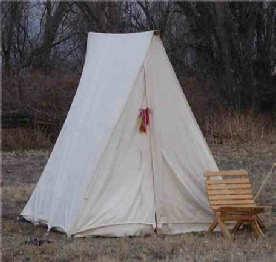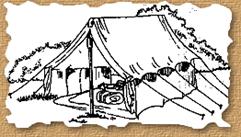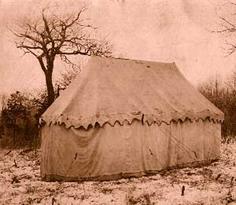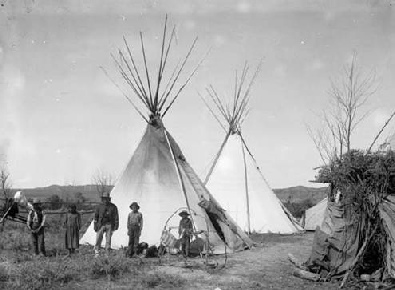Subject Guide

Mountain West
Malachite’s Big Hole
Shelter:
Tents are mentioned often enough in the journals of the mountain men to know that they were not rare. But whether these tents were sewn and constructed to serve as shelter, or were just sheets of canvass spread between convenient trees and bushes is not known. While on the hunt, the mountain man likely lived under the stars and sun, whether they were showing or not. Osborne Russell writes in his journal, that at one time during some extremely nasty weather, they laid out the skin of a fresh killed buffalo on the mud, on which they laid under their blankets and robes. During the night, their bodies settled into the mud, and water ran onto the buffalo skin, filling the depression around their bodies. The only way to keep warm was to avoid moving and not letting fresh, cold water flow into the depression. Surely if some better form of shelter had been available, they would have used it. Rufus B Sage (Reference) describes the bed of a mountain man as "...an article neither complex in its nature nor difficult in its adjustment. A single buffalo robe folded double and spread upon the ground, with a rock, or knoll, or some like substitute for a pillow, furnishes the sole base-work upon which the sleeper reclines, and enveloped in an additional blanket or robe, contentedly enjoys his rest." Russell also writes on another occasion after a disastrous river crossing in which all of the parties equipment was lost on a raft which was swept down-stream “We were now on the side (of the stream) from whence we started, without a single article of bedding except an old cloth tent whilst the rain poured incessantly.” The tent was probably made of canvass.
The form of the tents referred to in the journals are not generally known. Alfred Jacob Miller, an artist who attend the 1837 Rendezvous depicts wedge tents in several of his drawings. Charles Larpenteur (Reference) who attended the 1833 Rendezvous states that “In a short time a tent was rigged up into a kind of saloon,...” This must have been a wall tent of some sort.
Below are described a number of types of tents in use during the early 1800’s. The more elaborate types if used at all would have been used by the bourgeois leading the pack train as a store and office.
The Wedge Tent was a style of tent in use from the 1750’s through to the 1860’s .
The style had few changes over this period except for size, and relatively minor
changes in shape. The size at the base was generally 6 feet wide by 6-8 feet long
with a height at center of 5 to 6 feet. The tent consists of a canvas rectangle
thrown over a ridge pole held up in the front and back with vertical poles. The
back is enclosed, and the front has a center opening doorway. The entire perimeter
was staked down. The wedge tent was the standard tent for common soldiers as the
military moved through out the west, but was also used extensively by travelers,
traders and trappers during this period. Alfred Miller painted wedge tents as part
of Sublette’s caravan to the 1837 Rendezvous. The wedge tent was also common equipment
supplied to Hudson’s Bay Company brigades in the mid 1800’s.
.
The style had few changes over this period except for size, and relatively minor
changes in shape. The size at the base was generally 6 feet wide by 6-8 feet long
with a height at center of 5 to 6 feet. The tent consists of a canvas rectangle
thrown over a ridge pole held up in the front and back with vertical poles. The
back is enclosed, and the front has a center opening doorway. The entire perimeter
was staked down. The wedge tent was the standard tent for common soldiers as the
military moved through out the west, but was also used extensively by travelers,
traders and trappers during this period. Alfred Miller painted wedge tents as part
of Sublette’s caravan to the 1837 Rendezvous. The wedge tent was also common equipment
supplied to Hudson’s Bay Company brigades in the mid 1800’s.
The Wall Tent began to see use in military camps in the mid 1750’s, primarily as
an  officers tent and for utility purposes. In the 1840’s the standard officer’s
tent covered an area seven feet wide by about ten feet long, having walls about three
feet high. The height of the tent at the peak was about eight feet. The pitch of
the roof was the same as the wedge tents assigned to the common soldiers. The interior
of the wall tent could be divided into a small section large enough for a cot and
some personnel belongings, and an office area. These tents were also used for kitchens,
bakeries, hospitals and for storage. Wall tents undoubtedly saw use in the western
fur trade, although there is only one reference one being used as a store for trade
with the Indians in 1842 (Hanson, Charles, 1980).
officers tent and for utility purposes. In the 1840’s the standard officer’s
tent covered an area seven feet wide by about ten feet long, having walls about three
feet high. The height of the tent at the peak was about eight feet. The pitch of
the roof was the same as the wedge tents assigned to the common soldiers. The interior
of the wall tent could be divided into a small section large enough for a cot and
some personnel belongings, and an office area. These tents were also used for kitchens,
bakeries, hospitals and for storage. Wall tents undoubtedly saw use in the western
fur trade, although there is only one reference one being used as a store for trade
with the Indians in 1842 (Hanson, Charles, 1980).
The Marquee was a standard military tent of the 1700’s. During its period of use, it was an officer’s tent. The marquee is generally an oval or rectangular side-walled
tent, with a peaked roof supported by two center poles with a ridge pole between
them. The sides of the tent are not permanently attached to the roof, and are
supported by shorter poles. The tent was further supported by guy ropes and stakes.
The scalloped roof edge is characteristic of the marquee tent. The marquee was
a large tent, with an average size of ten feet by fourteen feet and eight feet tall
at the center ridge. The interior could be subdivided into small rooms and an office.
In hot weather the side walls could be let down or removed entirely. Because it
required wagon transportation it tended to be used only by high ranking officers.
Two or more marquees could be pitched adjacent to each other creating a very large
working or living space.
it was an officer’s tent. The marquee is generally an oval or rectangular side-walled
tent, with a peaked roof supported by two center poles with a ridge pole between
them. The sides of the tent are not permanently attached to the roof, and are
supported by shorter poles. The tent was further supported by guy ropes and stakes.
The scalloped roof edge is characteristic of the marquee tent. The marquee was
a large tent, with an average size of ten feet by fourteen feet and eight feet tall
at the center ridge. The interior could be subdivided into small rooms and an office.
In hot weather the side walls could be let down or removed entirely. Because it
required wagon transportation it tended to be used only by high ranking officers.
Two or more marquees could be pitched adjacent to each other creating a very large
working or living space.
 The Pyramid or Miner’s tent saw use starting in the 1840’s. These four sided tents
were set up with a single center pole, or might be suspended at the peak from an
overhanging tree branch. Pyramid tents ranged in size from about 7 feet on a side
to 15 feet on a side. Smaller tents might be staked only at the corners, whereas
larger pyramids would have additional intermediate stakes as well.
The Pyramid or Miner’s tent saw use starting in the 1840’s. These four sided tents
were set up with a single center pole, or might be suspended at the peak from an
overhanging tree branch. Pyramid tents ranged in size from about 7 feet on a side
to 15 feet on a side. Smaller tents might be staked only at the corners, whereas
larger pyramids would have additional intermediate stakes as well.
Lean-tos: This is one of the simplest and most basic forms of shelter. It is constructed by stretching a sheet of canvas between two uprights on one side, and down to the ground on the backside. More elaborate lean-tos will have end flaps and a door covering as well. There is no doubt that the mountain men sheltered under lean-tos because a canvas sheet had so many other uses in addition to being used as a shelter.
Tipi: In their journals and other records, it is often noted that mountain men would winter over with Indians, or married into or were adopted by different Indian peoples. It is almost certain that during these times they utilized the tipi as the form of shelter. Because of their size and requirement for long poles, it is extremely unlikely that tipis were taken with the Mountain Men during the fall and spring hunts. Rudolph Kurz, in his journal describes setting up a "tent" for use in a horse camp, but the description he gives is that of a tipi.
The earliest mention of the tipi comes from Coronado in his explorations of 1540-1542.
He notes that buffalo hunters lived in skin tents, spread over a frame of poles.
These Indians used dogs to transport their gear, because at this time only the Spaniards
possessed horses. Depending on the dog, a load of between 30 to 50 pounds could
be transported. With large dogs, lighter tipi poles of up twenty feet could be pulled.
Other Spanish explorers record great trains of dogs carrying goods and poles. Fray
Alonso de Benavides reports five-hundred dogs in one train, each following one another.
With the acquisition of horses, the Indians were able to transport the materials
for larger tipis, over greater distances and more quickly.
poles.
These Indians used dogs to transport their gear, because at this time only the Spaniards
possessed horses. Depending on the dog, a load of between 30 to 50 pounds could
be transported. With large dogs, lighter tipi poles of up twenty feet could be pulled.
Other Spanish explorers record great trains of dogs carrying goods and poles. Fray
Alonso de Benavides reports five-hundred dogs in one train, each following one another.
With the acquisition of horses, the Indians were able to transport the materials
for larger tipis, over greater distances and more quickly.
Originally all tipis were made from buffalo hides. A small tipi of twelve feet in diameter might require eight to ten buffalo hides. A tipi 18-20 feet in diameter would require twenty-four or more hides to complete. As canvas fabric became available from traders, it was adapted for tipi construction because of its relatively lighter weight and ease of use. Canvas in the mountains was a costly item, and may have required as many hides in payment as was required for construction of a tipi. In 1848, while he was staying at St. Joseph, Missouri, Rudolph Kurz (reference) states that "The Indians...pitched their tents of skins (or, as often happened, of white cotton cloth)..."
There are two main classes of tipis, those which use three poles and those which use four poles as the base unit on which all the other poles are placed. The Blackfeet, Shoshoni, Crow, Hidatsa, Ute and Comanche peoples used the four pole base unit for their tipis. The three pole base unit was used by the Kiowa, Cheyenne , Arapahoe, Sioux, Mandan, Arkikara, and Assiniboine. Each tribe then had differences in tipi construction unique to their people. Tribes which were closely associated might have very similar tipis, but not always. Being able to recognize the differences between tribal tipis was an advantage to the Mountain Man, in that it allowed an early identification of the tribe when approaching an Indian encampment.
Winter Camp: During the winter, when it was next to impossible to hunt beaver in the frozen streams and ponds, and travel was difficult the mountain men would "hole up", usually in a location were game animals and forage was abundant. It was during the winter that shelter was most necessary and often the trappers would purchase a used tipi for use during the winter. Rufus Sage in his book, "Rocky Mountain Life" provides an excellent description of a mountain man's winter camp.